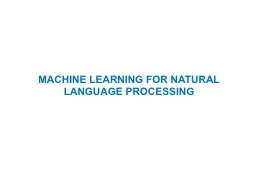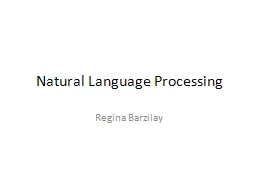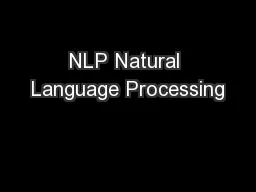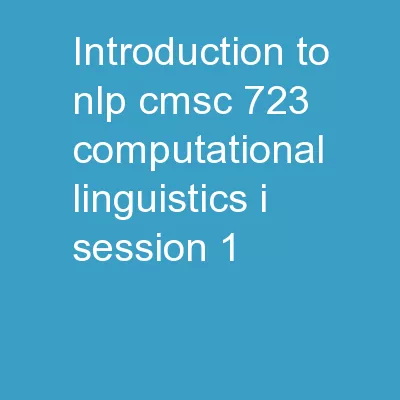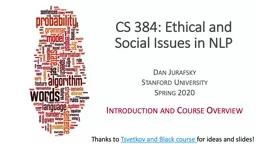PPT-NLP Introduction to NLP Cocke
Author : liane-varnes | Published Date : 2019-06-19
Kasami Younger CKY Parsing Notes on Left Recursion Problematic for many parsing methods Infinite loops when expanding But appropriate linguistically NP gt DT N
Presentation Embed Code
Download Presentation
Download Presentation The PPT/PDF document "NLP Introduction to NLP Cocke" is the property of its rightful owner. Permission is granted to download and print the materials on this website for personal, non-commercial use only, and to display it on your personal computer provided you do not modify the materials and that you retain all copyright notices contained in the materials. By downloading content from our website, you accept the terms of this agreement.
NLP Introduction to NLP Cocke: Transcript
Kasami Younger CKY Parsing Notes on Left Recursion Problematic for many parsing methods Infinite loops when expanding But appropriate linguistically NP gt DT N NP gt PN DT gt NP s. John Blitzer. 自然语言计算组. http://research.microsoft.com/asia/group/nlc/. Why should I know about machine learning? . This is an NLP summer school. Why should I care about machine learning?. Detecting Questions in Micro-text. Kyle Dent <. kdent@parc.com. >. Original Question: Do people use Twitter to ask questions?. First Answer: Of course.. But to what extent and what kinds of questions?. the almighty……….. . NLP. . DR.Eman. . Diab. introduction. introduction. The word . Neuro. linguistic programming can be broken down to three distinct words: . Outline. Some Sample NLP Task . [Noah Smith]. Structured Prediction For NLP. Structured Prediction Methods. Conditional Random Fields. Structured . Perceptron. Discussion. Motivating Structured-Output Prediction for NLP. Subproblems. . Meliha. . Yetisgen-Yildiz. From last week’s discussion. Presentation. Schedule. : . http. ://faculty.washington.edu/melihay/. MEBI591C.htm. 50 . minutes . presentation+discussion+question. Regina Barzilay. What is NLP?. Goal: intelligent processing of human language. Not just effective string matching. Applications of NLP technology:. Less ambitious (but practical goals): spelling corrections, name entity extraction. Class Logistics. Quiz. Where is this quote from?. Dave Bowman. : Open the pod bay doors, HAL.. HAL. : I’m sorry Dave. I’m afraid I can’t do that.. Quiz Answer. “2001: A Space Odyssey” . 1968 film by Stanley Kubrick . Who wrote which Federalist papers?. 1787-8: anonymous essays try to convince New York to ratify U.S Constitution: . . Jay, Madison, Hamilton. . Authorship of 12 of the letters in dispute. 1963: solved by . S . -> NP VP. NP -> DT N | NP PP. PP -> PRP NP. VP -> V NP | VP PP. DT -> 'a' | 'the'. N -> 'child' | 'cake' | 'fork'. PRP -> 'with' | 'to'. Parser. Earley. parser. Problems with left recursion in top-down parsing. VP . . VP PP. Background. Developed by Jay Earley in 1970. No need to convert the grammar to CNF. Left to right. Complexity. Jimmy Lin. The . iSchool. University of Maryland. Wednesday, September 2, 2009. NLP. IR. About Me. Teaching Assistant: . Melissa Egan. CLIP. About You (pre-requisites). Must be interested in NLP. Must have strong computational background. Biomedical Informatics. UC San Diego. October 13, 2016. Chunnan Hsu. Ramana. . Seerapu. Scott Duvall. Olga Patterson. Hua Xu. Michael Matheny. Glenn . Gobbel. Tsung. -Ting . Kuo. Current members. The NLP working group is tasked to accurately extract phenotypes for three clinical conditions: Kawasaki Disease (KD), Weight Management / Obesity (WM/O), and Congestive Heart Failure (CHF), from tens of millions of clinical notes shared by participating institutes in . Dan Jurafsky. Stanford University. Spring 2020 . Introduction and Course Overview. Thanks to . Tsvetkov. and Black course . for ideas and slides!. How should we use NLP for good and not for bad?. The common misconception is that language has to do with . Smoothing. If the vocabulary size is |V|=1M. Too many parameters to estimate even a unigram model. MLE assigns values of 0 to unseen (yet not impossible) data. Let alone bigram or trigram models. Smoothing (regularization).
Download Document
Here is the link to download the presentation.
"NLP Introduction to NLP Cocke"The content belongs to its owner. You may download and print it for personal use, without modification, and keep all copyright notices. By downloading, you agree to these terms.
Related Documents




